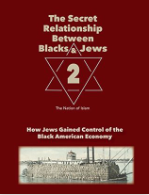The Secret Relationship Between Blacks and Jews, Volume 2: How Jews Gained Control of the Black American Economy by The Nation of Islam (PDF)
The Secret Relationship Between Blacks and Jews, Kindle edition, is the Nation of Islam's official digital version of the paperback second edition. Drawing almost entirely from Jewish documents, the first volume of this series (1991) presented a comprehensive overview of the Jewish people's involvement in the trans-Atlantic slave trade. In its 512 pages, Volume Two of The Secret Relationship Between Blacks and Jews reveals that as merchants and businessmen, Jews gained much in a repressive Jim Crow society. In fact, this book answers the provocative question, If Blacks did not receive the 40 acres and a mule, then who did? Jews openly spoke of the benefits of scapegoating Blacks in the South, and Jewish politicians helped create and enforce the Jim Crow laws that kept Blacks from developing an economic foundation. Jews even altered the practice of their religion to accommodate the racist Southern traditions. Jewish merchants in the post-Civil War South were leaders in the financial exploitation of the newly freed slaves, targeting the Black cotton sharecroppers and growing extremely wealthy in the process. Many notable Jewish families and institutions, including the Lehman Brothers, Neiman Marcus, and even the infamous Rothschild family of international bankers, can trace their wealth to the cotton fields of the American South. Under Jewish leadership, AFL unions became the instrument of white working-class racism and began systematically forcing Black workers out of a variety of occupations they once dominated. Many Jewish labor officials fought for government policies that sought the total removal of Asians from American soil. Jews were found collaborating with and even financing such domestic racial terrorists as the Ku Klux Klan. Jews became Klan members and some even supplied the Klan with guns, sheets, and hoods. When lynchings and massacres occurred in America, Jewish leaders often praised these outrages, and some in the Jewish press cheered them on. Volume 2, Kindle Edition, contains thousands of quotations and footnotes, cites Jewish scholars, rabbis, and Jewish newspapers, and includes maps, diagrams, charts, photographs, and a bibliography.

Category:
The Nation of Islam
Tags:
History